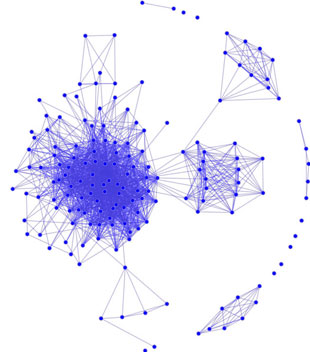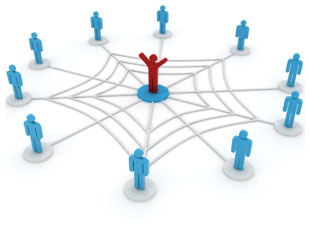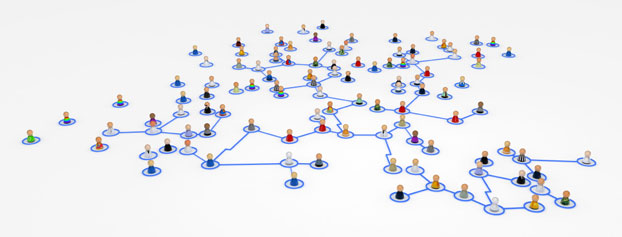Networking Communities
1 Introduction
Scale-Free networks are a developing understanding being brought together by observations that have been undertaken in the physical world of structures, Cellular Metabolism, Research Collaborations, Relationships, the Internet and the World Wide Web.
Research has uncovered that in these relationship that key nodes can and do create sectors of vulnerability, that highly connected individuals can provide greater levels of influence. Social scientists have unearthed a wide range of empirical evidence that the quality of life and the performance of social institutions are influenced by norms of networks of civic engagement.
The norms and networks of civic engagement also powerfully affect the performance of representative government. As Robert Putman opined Voter turnout, newspaper readership, membership in choral societies and football clubs--these were the hallmarks of a successful local community. He suggested that, historical analysis that these networks of organized reciprocity and civic solidarity, far from being an result of socioeconomic modernisation, were a precondition for it.
For a variety of reasons, life is easier in a community blessed with a substantial stock of social capital. In the first place, networks of civic engagement foster sturdy norms of generalised reciprocity and encourage the emergence of social trust. Such networks facilitate coordination and communication, amplify reputations, and thus allow dilemmas of collective action to be resolved. When economic and political negotiation is embedded in dense networks of social interaction, opportunities for abuse are limited. At the same time, networks of civic engagement embody past success at collaboration, which can serve as a cultural template for future collaboration.
In the 21st Century as we become more knowledgeable about these systems it is at the same time they are subjected to a number of factors that increasingly threaten their survival. Changing patterns of work and lifestyles make increasing demands on an individuals time and resources. The expansion of leisure activities has widened choice from the local clubs and societies to new varieties of sports and activities. The emergence of 24/7 television and they pressure to fill prime time has reduced the numbers of participants in ad-hoc social activities.
More importantly those activities that demand of us “time and organisation” are suffering, in Putman’s example of bowling alone the message was not one of decline in personal bowling but of organised leagues and competition. No one was any longer prepared to organise, promote and maintain the other participants interest, schedule the venues and arrange finances, giving the venture the cement that ensured its survival over a period of time.
In the United Kingdom the decline in political participation is a result of a number of factors, the age of the average participant is higher that it was in the past, reflecting the inability to attract the younger member. The income from membership is declining in many parties, as the existing membership dies and are not replaced. The amount of time demanded of existing organisers is increasing as membership decline. In sport this is seen as a major disincentive to individuals volunteering to devote time to administrative tasks that support their clubs. Time Poor individuals are far more common than they used to be.
All of this requires us to study the structure of successful organisations and emulate these structures in as many ways as possible. To do this we can understand that one of the major benefits of belonging is to know that others who belong have a common interest. We also now understand that the act of belonging in itself confers a benefit, this benefit is likely to be real. An example of this is the American Association of Retired Persons, this organisation grew from small beginnings in 1960 to a membership of 33 million 30 years later.
For membership organisations the power of being a member has to be real, to be engaged has to have value and to participate should be rewarding and beneficial. In the past the reliance on volunteers made some organisations place unrealistic demands on them, while at the same time the organisation had no real mechanism for placing a value of the volunteers contribution.
Scholarship has addressed this conundrum in many ways in the past, recently it has become acceptable to refer to Social Capital as a measurement tool. Using the definition it is possible to calculate the contributions made to an organisation and its sum of Social Capital. Equally it is possible to measure the loss of capital when membership falls.

Existing organisation have a responsibility both to the past and the future, to especially husband the Social Capital for the future members, the challenge that presents itself to us is how to learn and build on our new understanding of social networks. The network models of the internet have shown the way, the have created real models of existing structures that so closely relate to social organisation we can recognise the model.
The implication is that a strong social organisation is a robust scale free model, that any other model will work but will probable only survive in a single form for a limited period of time. A robust model must be open, trustworthy and scale free.
2 Support
The above is now recognised by Local and Central governments, the growth of NGO’s supported by taxation is a measure of this. NGO are now recognised as being another channel of social improvement, providing alternatives where none existed before. The NGO will become the powerful NODE in the overall structure providing those vital connections and support to the emerging social groups.
In some cases these groups are well established in others they have arisen out of local demand and need. Some will have a responsive and supporting membership with subscriptions and fees for events, others will be completely dependent on grant income.
In all cases the long-term viability of the group or organisation is dependent on how much support it can gather, it doesn’t not matter whether the support is by grant or by subscription and fee income the willingness to provide this support is based on the perceived benefits received.
Research findings are interesting in other respects as well, groups that have a long term future (sustainable) are well managed and don’t demand too much of their volunteer workforce, they are transparent in so far as the management committee’s have ready access to membership and financial information. They can also scale their operation and network without excessive increases in cost at each nodal point.
With today’s technology the running of these groups is somewhat easier than in the past, but not without its risks, Group member information held on a computer in a members home certainly at risk from damage, theft, lack of proper maintenance and backup and shared support. Even web based services supported by a group can become unusable when the webmaster takes his leave.
We have to provide services that can be available to a number of users at once, at least the management committee and available when they want it.
3 Structure
Scale free structures are ideal for systems that support formal organisations with very large numbers of participants. These organisations are not often commercial in nature and those where they are not commercial are often funded from public funds. Sports Associations in particular often rely on the upper echelons of the sport to attract the interest and support of the lower echelons to provide the income that flows back to support the Grass Roots. Others such as research charities rely on giving and voluntary labour to generate the income to support their professional activities.

The structure should be capable of infinite expansion from any point within itself and even to be able to spawn a copy (clone itself) enabling organic expansion to take place. In the organisation different nodes can be different classes, however the common components are always the same, it has links to other nodes and it has participants.
Once these become accepted facets of the organisation it is possible to build across and onto this framework.
If for example the organisation is a sports body it is likely that there will be a governing body, regional groups and clubs that are members of these regional groups, clubs in turn will have a membership. Events will be organised on a regional and national basis with local events such as training and socials being arranged at the club level. With this multiple levels of organisation the scale free structure is essential to reduce the impact of failed clubs(node) or counties (hubs).
In this example the higher levels (hubs) can provide assistance and encouragement to the clubs (nodes), they can communicate downward and proliferate good practise, for their part the clubs act as feeders from the grass roots community to the higher echelons of the sport.
In the example of a non sports organisation the motivations may be varied but the structure is much the same, nodes have a membership and each node is related to a hub. This relationship is constantly repeated. In these organisation the membership may provide the finance to promote their interests or beliefs, in this case the flow of membership fees will be very dependent of the measure of activity promoting the members interests. Its interesting to note that Robert Putman found levels of high participation and involvement in pressure groups and environmental organisations where the communication to the grass roots was seen to be paramount. We witness in the political sector the high dependence of the parties on a small number of donors and benefactors, this Putman believes leads to the disengagement of the people with the political process.
In all case the structure can now be underpinned with new technology, our understanding of the true nature on scale free is evident when we examine the nature of the Internet. The whole structure has a series of weak points at its nodes where high degree of control is exercised or traffic has to request direction. However, the capacity and direction of these nodes is such that we will tolerate some infrequent failure to achieve an overall benefit.
In the case Albert-Laszlo Barabasi the story does not end there, in their publications they see the individuals commitment to their organisation through their membership as one of trust and contribution, in return the organisation is to provide a benefit. Importantly the membership will punish the organisation for failure even if there is some cost to the membership, in this regard the hub or node offering the support has to be careful not to become the target.
4 ActivityForum
ActivityForum provides the underlying technology that give organisations such as sports associations, professional bodies and political parties the tools to build their scale-free network.
ActivityForum provides for central control over the network structure of hubs, node and entities, these are for example Counties, Towns and Members. For the groups that belong to a larger organisation, the structure supports the typical hierarchical nature of these but provides for management where appropriate.
Membership can be optionally central or local or a mixture of both, in many cases membership subside because the mechanism for collection subscriptions has failed. ActivityForum provides for both the collection and reminder system at both the central and local levels.
In some organisations declining membership increases the pressure on their donor community, this method of fundraising was identified by Putnam as a major weakness in groups that are engaged in community activities and politics, he maintained that a substantial core of member activists was essential. You should be able to engage with the committed activist that is at the coalface of the organisations activities, this engagement is to solicit their views and support their commitment to the organisation with effective and open communications.
Participation is the key to all groups, ActivityForum plays heavily on communication and participation, communication can be at all group levels with the members of all groups directly in contact with the management of that group. All events in each node or group can be communicated across boundaries.
Key events can be promoted from the central organisation out to the subsidiary groups, syndication of publications ensure that the remote groups always have the opportunity to include new from the centre on their news pages.
Local events can be organised as public or private occasions with privacy of members being paramount members can manage the visibility of their details in such a way as to make themselves invisible to anyone but the membership management of their group.
Security of data is maintained in an environment where this can be professionally managed. Important membership information and statistics are available at one central point rather than fragmented system.
Addressing the effectiveness of any organisation is easier with profit and loss accounts and balance sheets, with the volunteer this is close to impossible. However, we do know that many active members of the community are those busy nodes of influence. To attract these participants into your groups their time has to be used effectively, and it should be demonstrable that you are using their time effectively. ActivityForum is a internet based system that enables all of the administration functions to be carried out anywhere where there is internet access.
If you want to learn more about Communtiy Networks read Linked it's nearly 10 years the book made its mark in Scientific American




